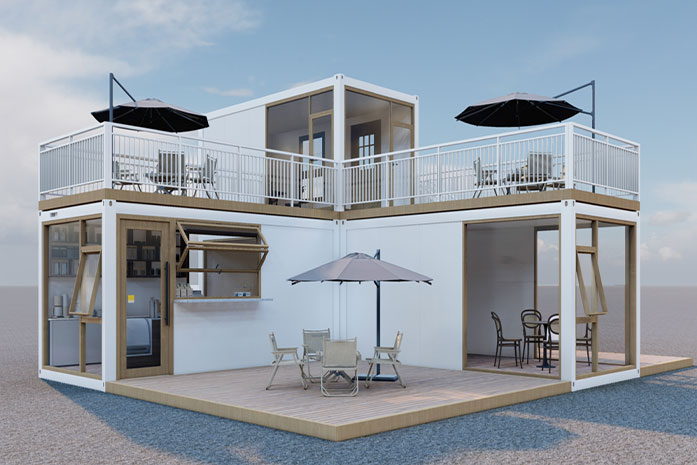What advanced materials and technologies are used in Apple Smart Cabin?
Sustainable Building Materials: This includes materials like recycled steel, bamboo, reclaimed wood, and other eco-friendly options that reduce the environmental impact of construction.
High-Performance Insulation: Advanced insulation materials can improve energy efficiency and reduce heating and cooling costs.
Smart Home Technologies: Integration of smart home systems for energy management, security, lighting, and other home functions.
Prefab and Modular Construction: Off-site manufacturing and assembly of building components to enhance efficiency and reduce construction time.
3D Printing: Using 3D printing technology to create complex and customized
Apple Smart Cabin.
Advanced Concrete and Cement: Development of concrete mixes with improved strength, durability, and reduced carbon footprint.
Energy-Efficient Windows and Glazing: High-performance windows that provide better insulation and reduce energy consumption.
Solar Panels and Energy Storage: Integration of solar panels and battery storage systems to generate and store renewable energy.
Green Roofs and Living Walls: Incorporation of vegetation on roofs and walls for improved insulation and aesthetics.
Water-Conserving Fixtures: Installation of water-efficient plumbing fixtures and systems to reduce water consumption.
Augmented Reality (AR) and Virtual Reality (VR): Using AR and VR for design visualization, project planning, and construction coordination.
Building Information Modeling (BIM): Digital representation of the building process, allowing for efficient design, collaboration, and construction management.
Waste Reduction Technologies: Implementing strategies to reduce construction waste and improve recycling efforts of
Apple Smart Cabin.
Advanced HVAC Systems: Energy-efficient and smart heating, ventilation, and air conditioning systems.
Structural Health Monitoring: Incorporating sensors and monitoring systems to assess the structural integrity of buildings over time.
What is the standardized process for Apple Smart Cabin?
A standardized process for an
Apple Smart Cabin might encompass various stages that involve the integration of technologies, features, and sustainable practices into the construction of houses. Keep in mind that the specifics of the process can vary depending on the company's approach and the technologies they are integrating.
Initial Consultation and Design:
Client consultation: Understand the client's preferences, needs, and goals for the integrated features.
Site assessment: Evaluate the building site for environmental factors, orientation, and feasibility of technology integration.
Design development: Collaborate with architects and designers to create a house plan that incorporates the desired integrated technologies and features.
Technology Selection and Integration Planning:
Identify integrated technologies: Choose smart home systems, energy-efficient appliances, sustainable building materials, and other features based on the client's requirements.
Integration planning: Develop a detailed plan for integrating chosen technologies into the house's design and construction.
Construction Preparation:
Permits and approvals: Obtain necessary permits and regulatory approvals for the integration of technologies and construction.
Material procurement: Source sustainable building materials and technologies according to the design plan.
Foundation and Infrastructure:
Site preparation: Clear the construction site and prepare the foundation.
Infrastructure installation: Lay the groundwork for integrated systems, such as wiring for smart home technology, solar panel installation, and energy-efficient HVAC systems.
Frame and Structure:
Build the frame: Construct the structural framework of the house.
Technology integration: Incorporate wiring and conduits for integrated technologies within the walls, ceilings, and floors.
Interior Finishes and Integration:
Installation of integrated features: Install smart home devices, energy-efficient lighting, appliances, and other integrated technologies.
Interior finishes: Complete the interior design with finishes that complement the integrated features.
Testing and Quality Assurance:
Technology testing: Verify the functionality of integrated technologies, including connectivity, automation, and energy efficiency.
Quality assurance: Inspect construction work and integrated systems to ensure they meet quality standards.
Client Orientation and Handover:
Client training: Provide homeowners with orientation and training on how to use and maintain integrated technologies.
Handover: Transfer the property to the client, ensuring they have all necessary documentation and information.
Post-Construction Support:
Warranty and support: Offer ongoing support and warranty for the integrated technologies and features.
Maintenance guidelines: Provide homeowners with guidelines for the maintenance and care of integrated systems.
Feedback and Evaluation:
Gather feedback: Collect feedback from homeowners about their experience with the integrated features and the construction process.
Continuous improvement: Use feedback to refine the standardized process and enhance future projects.










